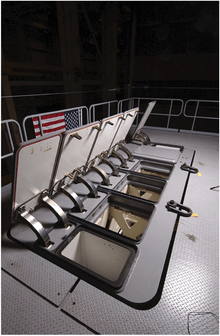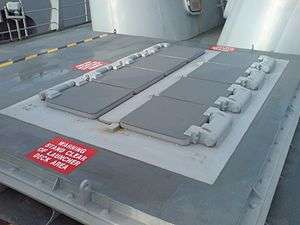Mark 41 Vertical Launching System
| Mk 41 Vertical Launching System | |
|---|---|
|
A single 8-cell Mk 41 VLS module fitted to New Zealand frigate HMNZS Te Kaha | |
| Type | Missile Launching System |
| Place of origin | United States of America |
| Service history | |
| In service | 1986 – present |
| Used by |
United States Navy and a number of others |
| Wars |
Cold War Tanker War Gulf War Kosovo War War on Terror |
| Production history | |
| Designed | 1970s |
| Manufacturer |
Martin Marietta Lockheed Martin |
| Variants | Mk 57 |
The Mark 41 Vertical Launching System (Mk 41 VLS) is a shipborne missile canister launching system which provides a rapid-fire launch capability against hostile threats.[1] The Vertical Launch System (VLS) concept was derived from work on the Aegis Combat System.[2]
History
Refinement of the initial concept of Aegis system in the 1960s continued through the 1960s and 1970s, and the Mk 41 was conceived in 1976.[2] Originally, the system was only intended to fire the RIM-66 Standard missile, but the height of the Mk 41 was increased to accommodate the larger Tomahawk missile.[2] The prototype for the launcher was tested and evaluated onboard USS Norton Sound (AVM-1). The first operational launcher was installed aboard USS Bunker Hill.[2]
Specifications
Mark 41
The Mk 41 is capable of firing the following missiles: RIM-66 Standard, RIM-67 Standard, RIM-161 Standard Missile 3, RIM-174 Standard ERAM, RGM-109 Tomahawk, RUM-139 VL-ASROC, RIM-7 Sea Sparrow, and RIM-162 ESSM.[2] The missiles are pre-loaded into "canisters", which are then loaded into the individual "cells" of the launcher. The ESSM is loaded in a quad-pack with 4 missiles in one Mk 25 canister.[2] Launcher cells are fitted to ships in 8 cell (2 rows of 4) modules that share a common uptake hatch (exhaust system) sited between the two rows.[2] Mk 41 VLS adopts modular design concept, which result in different versions that vary in size and weight due to different "canisters" in various modules. The height (missile length) of the launcher comes in three sizes: 209 inches (5.3 m) for the self-defense version, 266 inches (6.8 m) for the tactical version, and 303 inches (7.7 m) for the strike version. The empty weight for an 8-cell module is 26,800 pounds (12,200 kg) for the self-defense version, 29,800 pounds (13,500 kg) for the tactical version, and 32,000 pounds (15,000 kg) for the strike version.[2] Originally, one module would consist of five cells and a collapsible crane for assisting with replenishment at sea, but replenishment of large missiles at sea was later seen as impractical and dangerous, and modules with the cranes fell out of use.[2]
Mk 57

Mk 57 VLS is the development of Mk 41 VLS. Developed by Raytheon, the primary improvement of Mk 57 GMVLS (guided missile vertical launching system) over Mk 41 is its exhaust gas management system that can accommodate new missile designs having up to 45 percent greater rocket motor mass flow rate than that of Mk 41.[3] The unique symmetric geometry of the U-shaped gas management system facilitates the egress of gases, while minimizing flow into witness cells and reversed flow into the active cell. Elimination of a missile deluge system significantly reduces maintenance and personnel requirements, and protects against accidental missile wet-down.
| # of missiles | 4 |
| Width (ft/m) | 7.25 / 2.21 |
| length (ft/m) | 14.2 / 4.33 |
| Height (ft/m) | 26 / 7.93 |
| Weight (lb/kg) | 33,600 / 15,240 |
| Max canister width (in/m) | 28 / 0.71 |
| Max canister length (in/m) | 283 / 7.18 |
| Max encanistered weight (lb/kg) | 9,020 / 4,091 |
Variants
_Mark_41_Vertical_Launching_System.jpg)
According to NAVEDTRA 14324, Gunner's Mate, Chapter 7:
- MK 41 Mod 0, Ticonderoga-class cruisers, 61 cells forward and aft[5]
- MK 41 Mod 1, Spruance-class destroyers, 61 cells forward[5]
- MK 41 Mod 2, Arleigh Burke-class destroyers DDG-51 to DDG-78, 29 cells forward, 61 cells aft.[5]
- MK 41 Mod 3, Brandenburg-class frigates, 16 cells.
- MK 41 Mod 5, Anzac-class frigates, 8 cells
- MK 41 Mod 7, Arleigh Burke-class destroyer, DDG-79 to DDG-91, 32 cells forward, 64 cells aft.[6]
- MK 41 Mod 8, Barbaros-class frigates, (second pair of ships)
- MK 41 Mod 10, Sachsen-class frigates, 32 cells
- MK 41 Mod 15, Arleigh Burke-class destroyer, DDG-92 and up, 32 cells forward, 64 cells aft.[6]
- MK 41 Mod 16, Adelaide-class frigate, 8 cells
Mk 41 VLS in use by nations
_during_a_training_exercise.jpg)
- Adelaide-class frigate - (8 cells)
- Anzac-class frigate - (8 cells)
- Hobart-class destroyer - (48 cells)
- Iroquois-class destroyer - (29 cells) (Retired)
- Iver Huitfeldt-class frigate - (32 cells)
- Sachsen-class frigate - (32 cells)
- Brandenburg-class frigate - (16 cells)
- Atago-class destroyer - (96 cells)
- Kongō-class destroyer - (90 cells)
- Hyūga-class helicopter destroyer - (16 cells)
- Murasame-class destroyer - (16 cells)
- Takanami-class destroyer - (32 cells)
- Akizuki-class destroyer - (32 cells)
- De Zeven Provinciën-class frigate - (40 cells)
- Fridtjof Nansen-class frigate - (8 or 16 cells)
- Anzac-class frigate - (8 cells)
- Chungmugong Yi Sun-shin-class destroyer (KDX-II) - (32 cells)
- King Sejong the Great-class destroyer (KDX-III) - (80 cells)
- Álvaro de Bazán-class frigate - (48 cells)
- Naresuan-class frigate - (8 cells)
- G class frigate - (8 cells)
- Barbaros-class frigate - (16 cells)
- Spruance-class destroyer - (61 cells, installed on 24 of 31 vessels) (Retired)
- Arleigh Burke-class destroyer - (96 cells)
- Ticonderoga-class cruiser - (122 cells)
Gallery
_aboard_the_guided_missile_cruiser_USS_San_Jacinto_(CG_56).jpg) The VLS cells on board USS San Jacinto.
The VLS cells on board USS San Jacinto._stabilize_a_crate_containing_a_Tomahawk_cruise_missile.jpg) A Tomahawk missile canister being loaded into a VLS aboard the Arleigh Burke class destroyer USS Curtis Wilbur
A Tomahawk missile canister being loaded into a VLS aboard the Arleigh Burke class destroyer USS Curtis Wilbur_inspect_the_MK_41_Vertical_Launching_System_(VLS)_for_water_to_prevent_electrical_failure.jpg) VLS cells open for inspection aboard USS Fitzgerald
VLS cells open for inspection aboard USS Fitzgerald%2C_designed_to_intercept_short_to_medium-ranged_ballistic_missile_threats%2C_is_launched_from_the_Pearl_Harbor-based_Aegis_cruiser_USS_Lake_Erie_(CG_70).jpg) An SM3 departs the Mk 41 VLS aboard USS Lake Erie with uptake hatch and cell hatch open.
An SM3 departs the Mk 41 VLS aboard USS Lake Erie with uptake hatch and cell hatch open. VLS Strikedown crane folded, aboard USS Mitscher
VLS Strikedown crane folded, aboard USS Mitscher VLS Strikedown crane extended, aboard USS Hopper
VLS Strikedown crane extended, aboard USS Hopper Diagram of a Mk 41 Mod 0 VLS.
Diagram of a Mk 41 Mod 0 VLS.
See also
- Vertical launching system
- Sylver Vertical Launching System - a competitor to the MK 41 VLS
References
- ↑ "Mark 41 Vertical Launching System". Retrieved 21 September 2011.
- 1 2 3 4 5 6 7 8 9 Friedman, Norman (2006). The Naval Institute Guide to World Naval Weapon Systems (5th ed.). Annapolis, MD: Naval Institute Press. p. 600.
- ↑ Mk 57
- ↑ "MK 57 Vertical Launching System Zumwalt Class Destroyer Program" (PDF).
- 1 2 3 NAVEDTRA 14324, Gunner's Mate, Chapter 7.
- 1 2 U.S. Navy Guided Missile Launcher Systems Accessed May 15, 2014.
External links
| Wikimedia Commons has media related to Mark 41 Vertical Launching System. |
